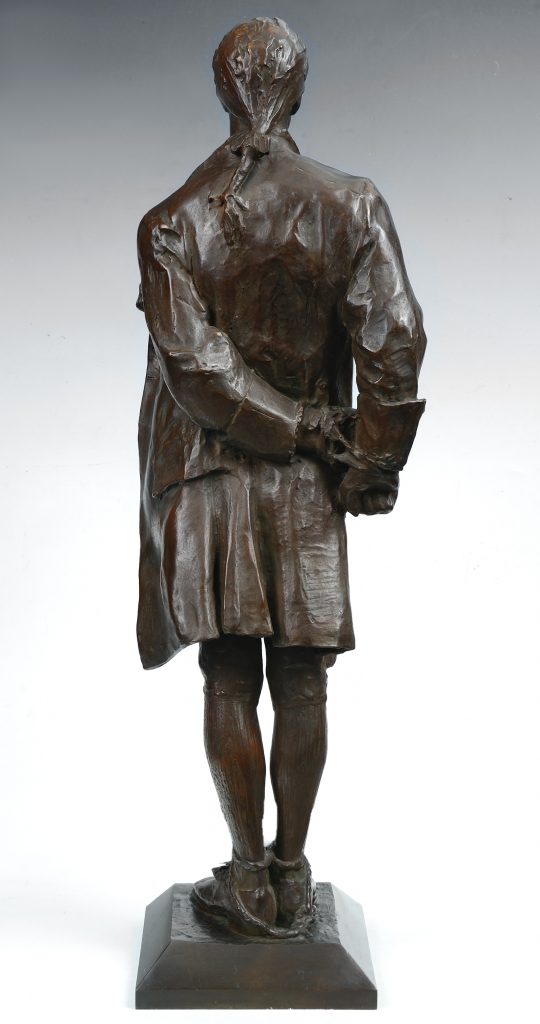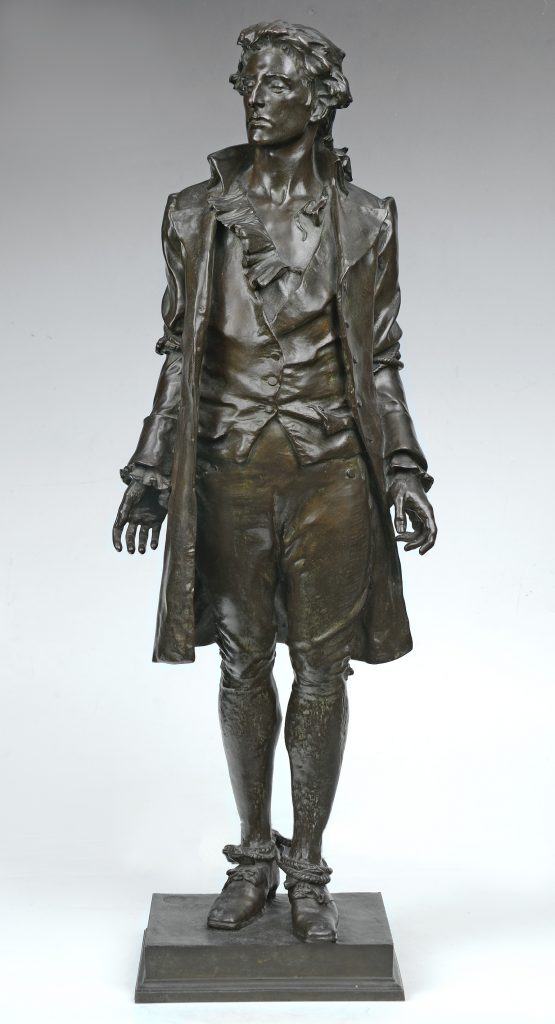
Frederick MacMonnies was one of two sculptors to create statues of Nathan Hale around the turn of the twentieth century. MacMonnies’ statue was unveiled in New York City in 1893, and reduced-size versions like this one were sold into the early twentieth century.
“I only regret that I have but one life to lose for my country.” The words Nathan Hale is said to have uttered just before being hanged as a spy by the British are among the best remembered of the Revolution. The young schoolteacher-turned-officer-turned-spy was a hero to nineteenth-century Americans, but they didn’t know what he looked like, as no contemporary likeness survived. Then two American sculptors working at the turn of the twentieth century imagined Nathan Hale in bronze statues. Their vision of the young hero—represented in three important works in the Institute’s collections—have shaped the way Americans have imagined Hale for more than a century.
Nathan Hale was an intelligent, engaging, athletic, ambitious and dutiful schoolmaster in New London, Connecticut, at the outbreak of the Revolutionary War. When news of the battles of Lexington and Concord reached New London on April 22, 1775, Hale reportedly declared: “Let us march immediately and never lay down our arms until we obtain our Independence.” He joined the Seventh Connecticut Regiment of the Continental Army as a lieutenant. After several months of recruiting, training, and watching the coastline, Hale’s regiment finally received orders in September to march to Cambridge, Massachusetts. He was promoted to captain as the regiment settled in to the Siege of Boston.
After the British evacuated Boston in March 1776, George Washington’s army—including the Seventh Connecticut—marched to New York to defend the city. That summer, Hale was selected for an elite company of rangers commanded by Col. Thomas Knowlton. By fall Washington had become anxious for information on the enemy’s movements. With scouting parties and citizen couriers proving to be ineffective, the general proposed that one of Knowlton’s rangers conduct one of the first American spy missions of the war. The effort required a soldier to disguise himself in civilian clothing, slip behind British lines, collect information and documents on the enemy’s next planned attack, and return to camp undetected. At a meeting, Knowlton asked for a volunteer. After a pause, Hale responded to the call.
Hale left camp on September 12 posing as a schoolmaster looking for work. He took a circuitous path to British-held Long Island, where he gathered information on the enemy’s numbers and positions. On the night of September 21, he was discovered on his way back to the American lines and captured. He was immediately taken to Gen. William Howe’s headquarters at Mount Pleasant and, because the general found Hale carrying incriminating papers and wearing civilian clothes rather than a military uniform, Howe declared the American a spy and ordered him hanged in the morning.
On September 22, 1776, the British marched twenty-one-year-old Nathan Hale north to their artillery park and executed him. The account of Hale’s famous last words—which were inspired by a similar line in Joseph Addison’s play Cato—comes from British engineer John Montresor, who witnessed the execution. Another British officer, Lt. Frederick Mackenzie, recorded Hale’s last moments: “He behaved with great composure and resolution, saying he thought it the duty of every good Officer, to obey any orders given him by his Commander-in-Chief; and desired the Spectators to be at all times prepared to meet death in whatever shape it might appear.” Later the same day, Montresor traveled to the American camp to deliver a message from Howe to Washington and told several officers of Hale’s fate. Despite Hale’s patriotic sacrifice, his story was little told in the eighteenth century—perhaps due to his mission’s embarrassing failure.
More than a century after his execution, the first statue of Nathan Hale was dedicated in New York in 1893. The bronze statue was erected by the Sons of the Revolution in the State of New York in City Hall Park, where Hale’s execution was thought to have taken place. (The site was actually four miles away near present-day 66th Street and 3rd Avenue on the Upper East Side.) The Brooklyn-born artist Frederick MacMonnies (1863-1937) sculpted the work, which is one of the best examples of American Beaux-Arts sculpture. MacMonnies was then in the early stages of his career, having worked in the studio of renowned American sculptor Augustus Saint-Gaudens, and studied at the National Academy of Design in New York and École des Beaux-Arts in Paris.
The competition for the Nathan Hale commission began in 1889, when the Sons of the Revolution announced their intention to erect a full-length statue of the hero in Manhattan. They sought designs for a standing figure of “a well-built young man of American type, dressed in a simple costume of the end of the last Century … at the moment immediately preceding his execution by the British, when his well-remembered words, ‘Would I had more than one life to give for my Country,’ were uttered.” Saint-Gaudens was the judge of the competition and declared MacMonnies and Paul Wayland Bartlett the only sculptors worthy of the commission.
MacMonnies was inspired by Hale’s idealism and refinement. “I wanted to make something that would set the boot-blacks and little clerks around there thinking — something that would make them want to be somebody and find life worth living,” the sculptor later said. In his studio in Paris he created a dramatic and resolute figure of Hale. His torn and open shirt and bound arms and ankles hint at his captivity, while his slightly raised chin and calm face project strength and pride. For Hale’s facial features, MacMonnies drew from a bust he sculpted of his friend, aspiring writer William Theodore Peters.
In September 1889, MacMonnies submitted a rough three-foot-tall plaster model to the Sons of the Revolution in New York. The Sons and the New York Park Commission approved the design, awarded MacMonnies a $5,000 prize, and set a deadline of December 1, 1890, to deliver an eight-foot-tall bronze version for installation in City Hall Park.
Back in Paris, MacMonnies cast the final model in early 1890 and submitted it for the 1891 Salon, where it won a second-class gold medal—the highest award open to foreigners and the first won by an American sculptor. Despite this success, the December 1890 deadline passed without a finished statue from MacMonnies due to delays in the production of a base. It was not until 1892 that the final bronze was cast at the Paris foundry Jaboeuf et Bezout and plans were made for an unveiling the following year.
MacMonnies’ statue of Nathan Hale—standing on a five-foot-tall pink granite base—was unveiled on November 25, 1893. (The statue has since been moved around the park four times, most recently in 1999, when it was placed in a grass plaza in front of the steps of City Hall.) MacMonnies retained rights to the statue and, beginning in 1890, he commissioned reduced-size versions of it to sell to the public. One of these statuettes is in the Institute’s collections, cast in Paris by Jaboeuf et Rouard, one of three foundries in France and the United States that MacMonnies chose for the commissions.
A second statue of Nathan Hale—commissioned by Yale University, from which Hale graduated in 1773—was created about the same time. This bronze work by Bela Lyon Pratt (1867-1917) was unveiled in 1914 outside Connecticut Hall, where Hale lived as a student. The idea for the monument originated with George Dudley Seymour, a New Haven patent lawyer. Seymour’s lifelong interest in Hale was sparked by reading a poem about the patriot as a boy. His passion led him to restore Hale’s homestead in Coventry, Connecticut, and to publish his extensive research on Hale’s life. In 1898, Seymour convinced officials at Yale to commemorate his hero, with the hope of completing a monument by the university’s bicentennial in 1901. A committee of alumni began the search for a sculptor immediately.
Seymour suggested emerging Connecticut-born sculptor Bela Lyon Pratt, whose professional pedigree resembled that of MacMonnies. Pratt modeled his first study for the Hale monument in 1899. The tableau depicts an indistinct figure of Hale surrounded by British soldiers—one to his left holds ropes that bind his chest and arms. A columned archway frames the scene. Pratt had at least one copy of this design cast by an unidentified foundry. The only known bronze version is preserved in the Institute’s collections.
As with the New York sculpture, delays pushed Yale’s project past its intended completion date. Pratt produced a second study for consideration by the Hale monument commission in 1907—a single full-length figure that he considered more realistic and perhaps more focused than his earlier design. Like MacMonnies, Pratt depicted the young patriot in his last moments before death, with his wrists and ankles bound. He may have been influenced by Seymour’s vision for the monument, to portray Hale as “tall, fair, and athletic … an ideal figure of a young man of the period—not a man of elegance and polish, so much as a man of nobility and courage.” As a model for Hale’s likeness, Pratt used a local man, Crary Brownell, who Seymour said “closely resembled the profile [of Hale] that was on the door at the Nathan Hale home in Coventry.” Pratt also referred to images of the Reverend Edward Everett Hale’s sons, who were said to resemble their ancestor.
The Yale committee finally awarded the Hale commission to Pratt in 1912 along with a $15,000 prize. The restrained, unpretentious and idealistic portrait of Hale no doubt pleased the committee. It projects youthful innocence and idealism with a realistic, modern face—rather than the romantic, “bombastic” (according to Seymour) look of MacMonnies’ statue. After Pratt received the commission, he sent each of the twelve members of the committee a bronze replica of his reduced-size model for the statue. They were cast by Roman Bronze Works, the preeminent American art foundry established in New York in 1897. The statuette in the Institute’s collections was cast by this foundry.
Pratt completed his full-size model for the statue in 1913, which was cast the same year. The unveiling in September 1914 took place 138 years to the month after Hale’s execution. Pratt’s portrayal of Hale also graced a postage stamp issued in 1925 and a commemorative medal struck the following year. Full-size bronze replicas of Pratt’s Hale statue were later installed outside the headquarters of the Central Intelligence Agency in Langley, Virginia, and the Department of Justice in Washington, D.C. With these statues of Nathan Hale, Bela Lyon Pratt and Frederick MacMonnies gave the nation tangible reminders of one of its first martyred patriots.
View More Sculptures
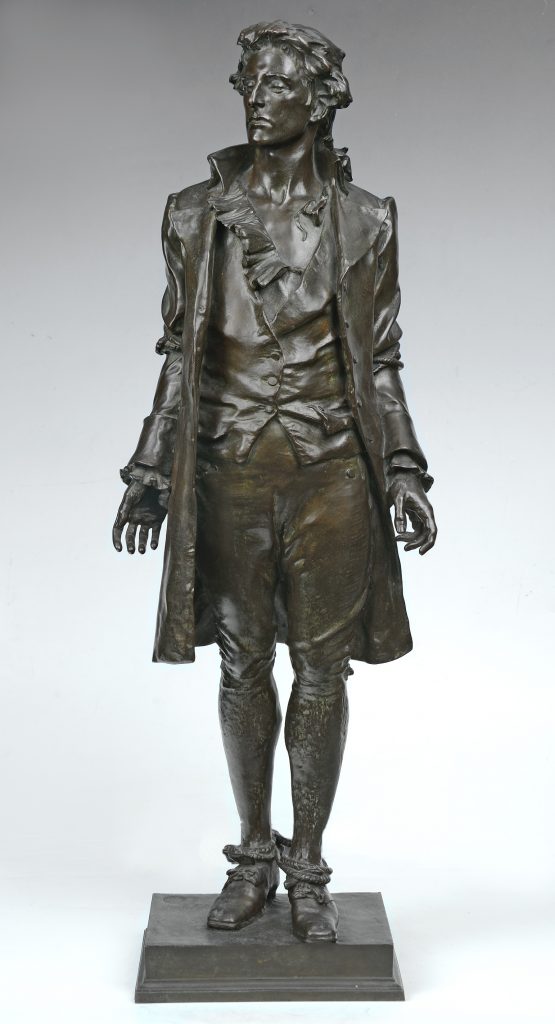
Nathan Hale
Frederick W. MacMonnies (1863-1937)
Cast by Jaboeuf et Rouard, Paris, ca. 1901-1917The Robert Charles Lawrence Fergusson Collection
Frederick MacMonnies was the first artist to memorialize Revolutionary War soldier Nathan Hale, with his full-length statue installed in New York’s City Hall Park in 1893. MacMonnies sold reduced-size bronze statuettes of the work, like this one, beginning in 1890.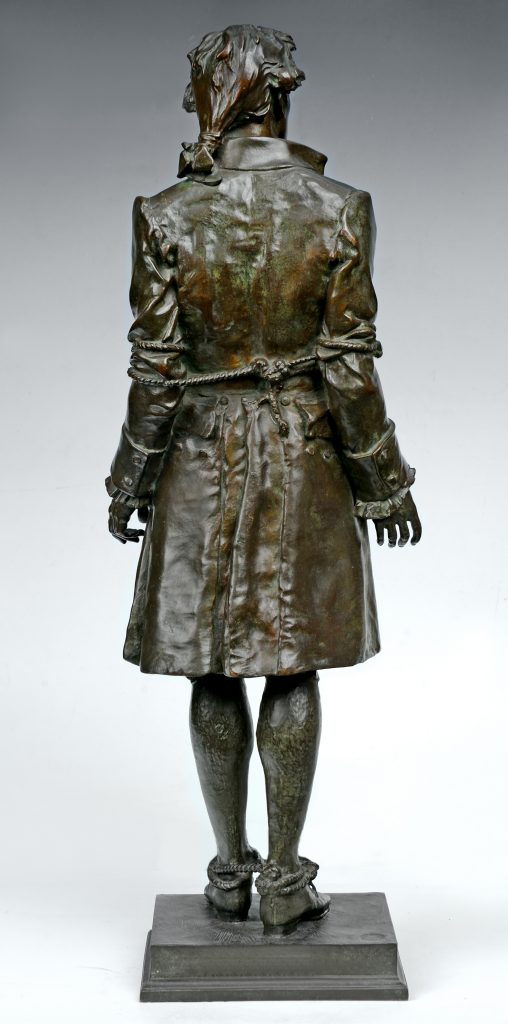
Nathan Hale (back)
Frederick W. MacMonnies (1863-1937)
Cast by Jaboeuf et Rouard, Paris, ca. 1901-1917The Robert Charles Lawrence Fergusson Collection
MacMonnies depicted Hale in the moments before his execution. The ropes tied around his arms and ankles identify him as a captive, but his strong posture implies a character willing to accept his fate.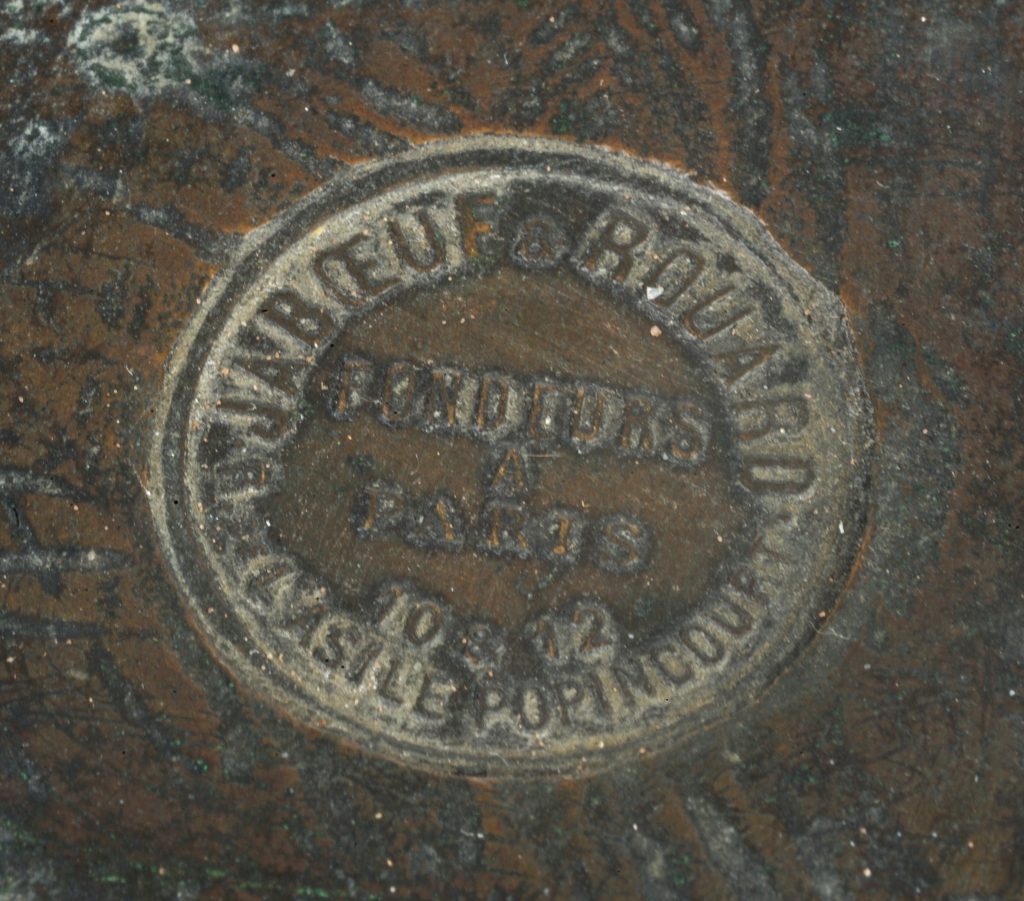
Foundry mark on Nathan Hale
Frederick W. MacMonnies (1863-1937)
Cast by Jaboeuf et Rouard, Paris, ca. 1901-1917The Robert Charles Lawrence Fergusson Collection
The foundry mark on the Institute’s example of MacMonnies’ statue of Hale identifies Jaboeuf et Rouard of Paris as the foundry that cast it—one of three foundries MacMonnies used to cast produce copies of his statue. Jaboeuf et Rouard operated from 1901 to 1917, establishing the date range when this statuette was made.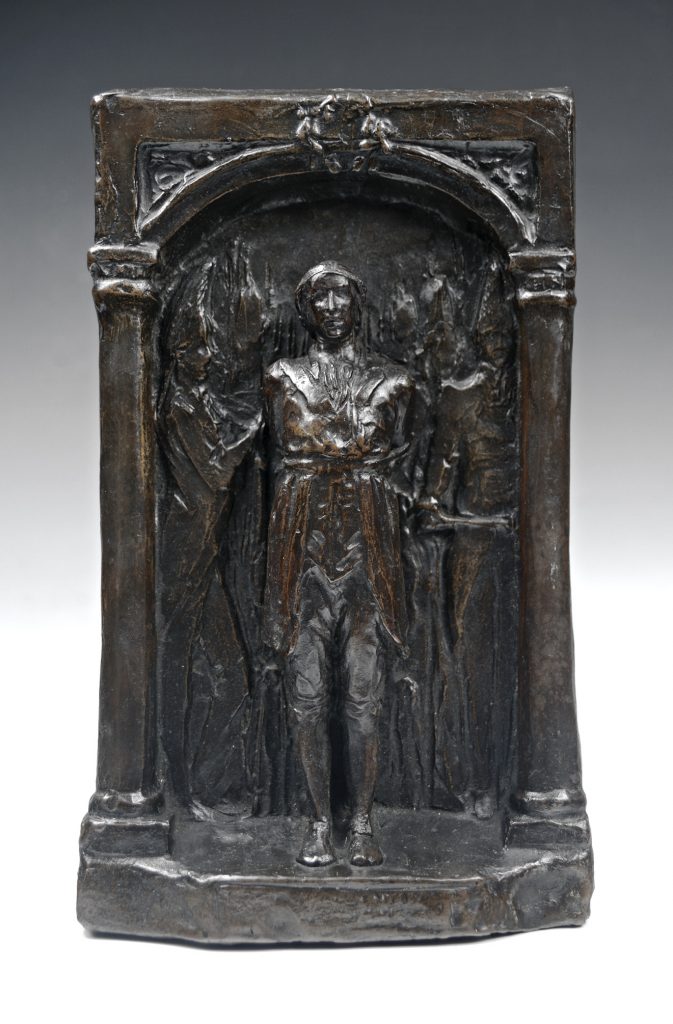
Nathan Hale
Bela Lyon Pratt (1867-1917)
ca. 1899The Robert Charles Lawrence Fergusson Collection
This preliminary study, or maquette, for the Yale University monument places Hale’s final moment in an architectural setting, with armed Redcoats in the background. It is the only known bronze cast of the work.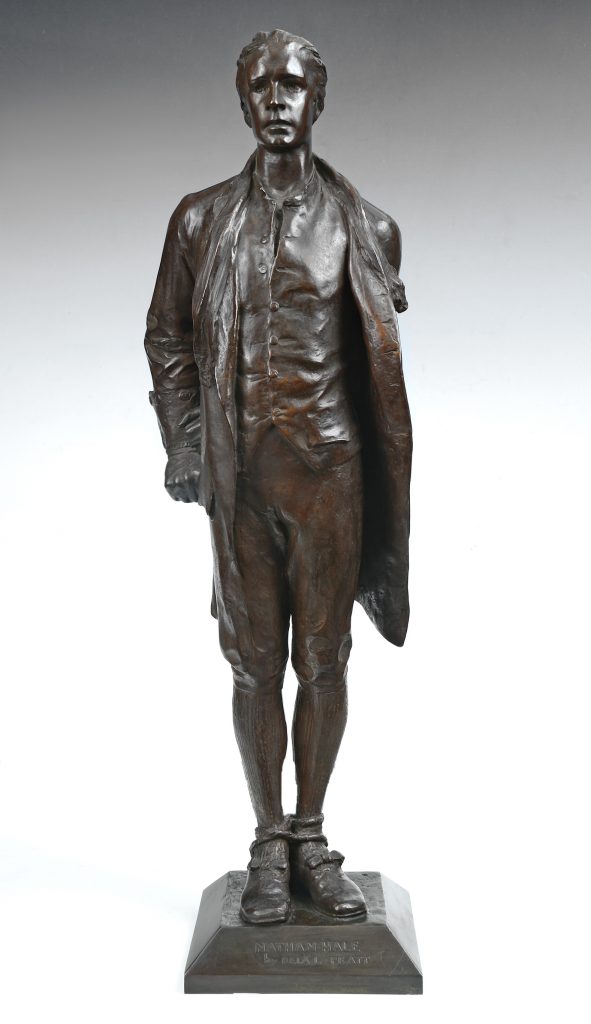
Nathan Hale
Bela Lyon Pratt (1867-1917)
Cast by Roman Bronze Works, New York, ca. 1913The Robert Charles Lawrence Fergusson Collection
Pratt completed a second study for the Yale University commission in 1907, depicting a brave and dignified Hale as a single figure. The university approved the design five years later, and the full-size bronze statue was unveiled on campus in 1914.